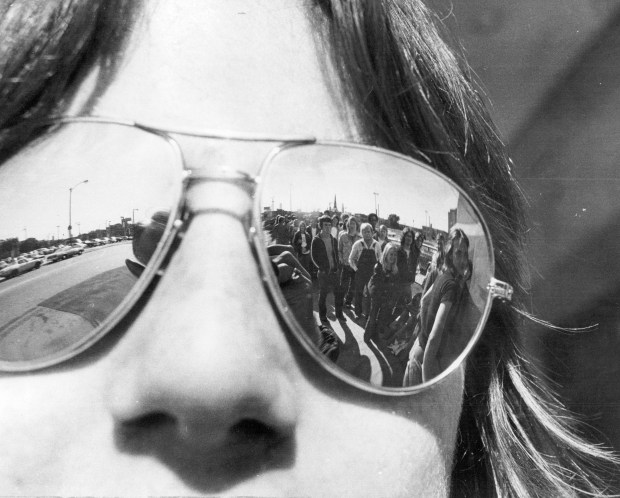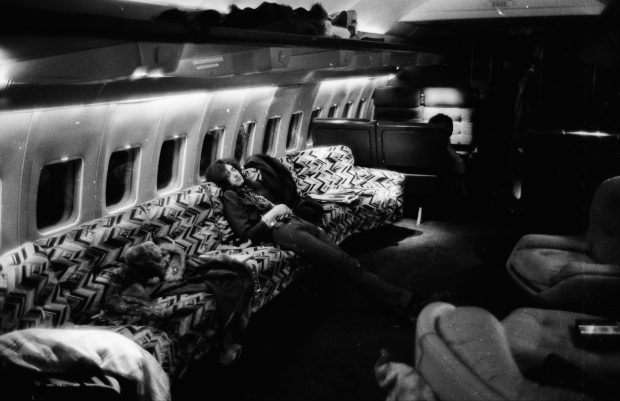Led Zeppelin didn’t specifically sing about “goin’ to Chicago” until 1971 when the band interpreted the 1929 country-blues song “When the Levee Breaks” for its untitled fourth album, familiarly known as “Led Zeppelin IV.” Yet the band’s deep ties to the city began earlier, overlapping part of the era profiled in the new documentary “Becoming Led Zeppelin” — opening on Feb. 5 at the Regal City IMAX location and more widely on Feb. 14. That connection continued until the quartet dissolved in the wake of drummer John Bonham’s death in September 1980.
That year, the British group was slated to perform four highly anticipated shows at what was then Chicago Stadium between Nov. 10 and 15. Full-page mail-order applications for tickets, priced at $10, $12.50 and $15, were printed in the Tribune on Sept. 25, 1980 — the same date Bonham was discovered in bed unresponsive, a victim of accidental asphyxiation from vomit.
In their desire to secure seats — only available via the print form since in-person sales for several of the band’s prior appearances resulted in mayhem — an estimated crowd of 1,000 mobbed a Tribune delivery truck on Michigan Avenue that morning to get their hands on the paper. They and other hopefuls submitted the document with money orders or certified checks before the events were canceled. Everyone who paid received a letter with refunds from the venue.
Six years later, local entrepreneur Michael Dehn entered the Guinness Book of World Records when he purchased for $9,000 the entire lot of nearly 80,000 unused tickets — printed by Chicago Stadium in advance of the on-sale date on multi-colored, card-stock paper that makes today’s digital tickets seem slight — for the group’s planned residency. Dehn sold them in various configurations to memorabilia collectors.
Oddly enough, in what served as an ominous omen, Led Zeppelin also scrapped its previously scheduled dates at Chicago Stadium. Planned for Aug. 2-3, 1977, the two shows got scrubbed after singer Robert Plant’s 5-year-old son died of a stomach virus that July.
While those six phantom concerts hold a unique place in history, Led Zeppelin played 18 total shows in Chicago during its tenure. None of the three area venues at which the group appeared survived the wrecking ball. Here’s a closer look at the ensemble’s time in the city.
Feb. 7-8, 1969, at Kinetic Playground
Led Zeppelin’s Chicago debut came less than two months after its first American gig and three weeks after its first U.S. show as a sole headliner that, of all places, happened in Iowa City, Iowa, when the band stepped up after Count Basie canceled his date at the students’ union. The two February performances at Kinetic Playground marked the first of eight the band played in 1969 alone at the venue that stood at 4812 N. Clark St. Sandwiched in the middle of a lineup that featured headliner Vanilla Fudge and opener Jethro Tull, Led Zeppelin drew positive reviews from the Tribune in its “The Sound” column branded “music and radio: for young listeners.”
May 23-24, 1969, at Kinetic Playground
Akin to its first appearance at Kinetic Playground, no concrete setlist information exists for the band’s late spring return. Though the prodigious bootlegging that followed the band for much of its existence remained about a year away — Led Zeppelin, still months away from releasing “Led Zeppelin II,” had yet to explode onto the mainstream — it secured headliner status for gigs that cost $5 and earned a “Swinging Things This Week-End” mention in the Tribune. Concert photos show Plant wearing a skin-tight tie-dye T-shirt and guitarist Jimmy Page laser-focused on what endures as his trademark instrument, a sunburst Gibson Les Paul.
July 18-19, 1969, at Kinetic Playground
An indicator of its budding reputation, Led Zeppelin broke the box office record at Kinetic Playground during its third go-round at the space. To celebrate its feat, the quartet reportedly received 18-karat gold Tiffany’s watches from venue owner Aaron Russo. Black-and-white pictures depict a vest-clad Page shaking hands with fans in the front row and Bonham’s large drum kit resting flat on the stage. A glowing review in the Chicago Sun-Times misspelled Page’s name as “Paige,” while a sophomoric Tribune rave exclaimed: “Wow, Led Zeppelin! Amazing!”
Oct. 19, 1969, at Kinetic Playground (two shows)
A rock concert that begins at 3 p.m.? In 1969, the matinee was a reality. And on a dream bill, no less. Supported by the Canadian ensemble Lighthouse and the now-legendary Santana — the California-based group less than two months removed from releasing its self-titled debut — Led Zeppelin played afternoon and evening shows to log eight shows in roughly eight months at the Uptown hall. Weeks later, Kinetic Playground suffered damage from a fire that led it to shutter until 1972. The venue ceased operation in 1973 and ultimately transformed into the Rainbo Roller Rink before demolition erased the building in 2003.
Sept. 5, 1971, at International Amphitheatre
On the cusp of issuing the landmark “Led Zeppelin IV” and on its largest North American tour yet, Led Zeppelin probably could have presided over a multi-night run at the storied Canaryville arena that hosted three Democratic and two Republican National Conventions. Because the band bypassed Chicago on its two 1970 American treks, this one-off date served as a live introduction to followers who came to the group in the 23 months since it appeared at the much smaller Kinetic Playground. They heard classics such as “Stairway to Heaven,” “Black Dog” and “Going to California” before “Led Zeppelin IV” hit store shelves. Posted on YouTube, nearly seven minutes of audience-shot Super 8mm video footage depict a young, hungry band in control of its destiny — and Plant dancing with a female fan. Alas, the quartet failed to sway the Daily News. In a scathing report, the paper wrote “the kind of music they personify is a dead-end on both musical and spiritual levels.”
July 6-7, 1973, at Chicago Stadium
As it did in 1970, Led Zeppelin skipped Chicago on its 1972 U.S. jaunt, prompting overwhelming demand for its first local appearances in almost two years. No surprise that police were called to handle the chaos that ensued at Woodfield Mall in Schaumburg and Randhurst Shopping Center in Mount Prospect when tickets for the 1973 dates went on sale at 10 a.m. By then, Led Zeppelin had become so popular that a few outlets opted out of carrying tickets due to the volume and hassle involved. Having sold out inside three hours, the shows witnessed the band winning over the local press, though the Chicago Sun-Times misidentified bassist-organist John Paul Jones as the band’s drummer — a gaffe that drew Plant’s ire on the second night. He and his mates also dealt with a violent audience and lax security issues at the Chicago Stadium. Speaking onstage on opening night, Plant said he’d never seen as many fights break out among a crowd. In a subsequent Tribune feature penned by critic Lynn Van Matre, he described “people wearing beads and punching each other in the face” and lamented the ugly vibes. The Chicago trip ended on a positive note. On July 8, Plant and Bonham traveled to the South Side nightclub Burning Spear to watch Bobby Bland jam with Chicago soul great Otis Clay.
Jan. 20-22, 1975, at Chicago Stadium
Fresh from an 18-month break from touring, Led Zeppelin came to Chicago in early 1975 with a batch of unreleased new material from its forthcoming double album “Physical Graffiti” to road-test. Alas, luck wasn’t completely on the group’s side. According to multiple accounts, including those of band members, the first night at Chicago Stadium failed to live up to expectations. Plant, vocally compromised due to complications from the flu, and Page, nursing a finger injury after he smashed his hand in a train door before departing England, also encountered a bad sound mix. Though Tribune scribe Van Matre felt the quartet compensated for the shortcomings, the group thought otherwise. After opening night caused Plant to briefly worry about band chemistry, Led Zeppelin met with its manager, Peter Grant, and road manager, Richard Cole, to strategize. The rap session worked. So did changes to its setlist (curiously, the Chicago-referencing “When the Levee Breaks” received its last-ever live performance on Jan. 20) and a few other adjustments. Led Zeppelin clicked for the remainder of the residency and restored what Plant deemed the ensemble’s “magic.” No doubt those who scored seats — priced at a reasonable $6.50, $7.50 and $8.50 to counter “existing economic situations” — agreed. In-the-know fans who made post-show treks to the Checkerboard Lounge or High Chaparral might have spotted the band in attendance. Seeking a genuine taste of Chicago blues, Led Zeppelin allegedly took limos to the South Side clubs after each of its Chicago Stadium shows concluded.

April 6-7 and 9-10, 1977, at Chicago Stadium
How crazed were Led Zeppelin zealots in 1977? Fervent enough to start camping out on Sunday night for tickets that went on sale on Wednesday. Once the latter date arrived, 75 additional Chicago police — including mounted patrol — were summoned to quell disturbances that led to 30 arrests. Ho-hum, just another of the many “riot” episodes in the group’s history. As for the first of what would become the band’s last run of Chicago shows? An example of “sheer power, ability and show of integrity” per Van Matre in a Tribune review of a 175-minute performance during which some fans ignited firecrackers inside the venue. Forced to end by 11 p.m. due to union demands and the Blackhawks’ need for the arena the next day, the second concert ran shorter. The April 9 date lasted for only about an hour. Curtailed due to the rail-thin Page supposedly ailing from food poisoning — in light of his glaring mistakes that night, many fans speculate the illness was owed to his drug abuse — the gig was later scheduled for an August make-up date. The finale of the stand, held Easter Sunday, remains notable for both Page wearing his infamous Stormtrooper outfit and Led Zeppelin turning in one of the tour’s finest performances. “Rock and Roll” was the last song the band would play in Chicago. With nearly 50 years elapsed since those final notes echoed on 1800 W. Madison St., it’s been a long time, indeed.
Bob Gendron is a freelance critic.
“Becoming Led Zeppelin” opens Feb. 5 at the Regal City IMAX, 2600 N. Western Ave., imax.com; wider release in theaters on Feb. 14.



